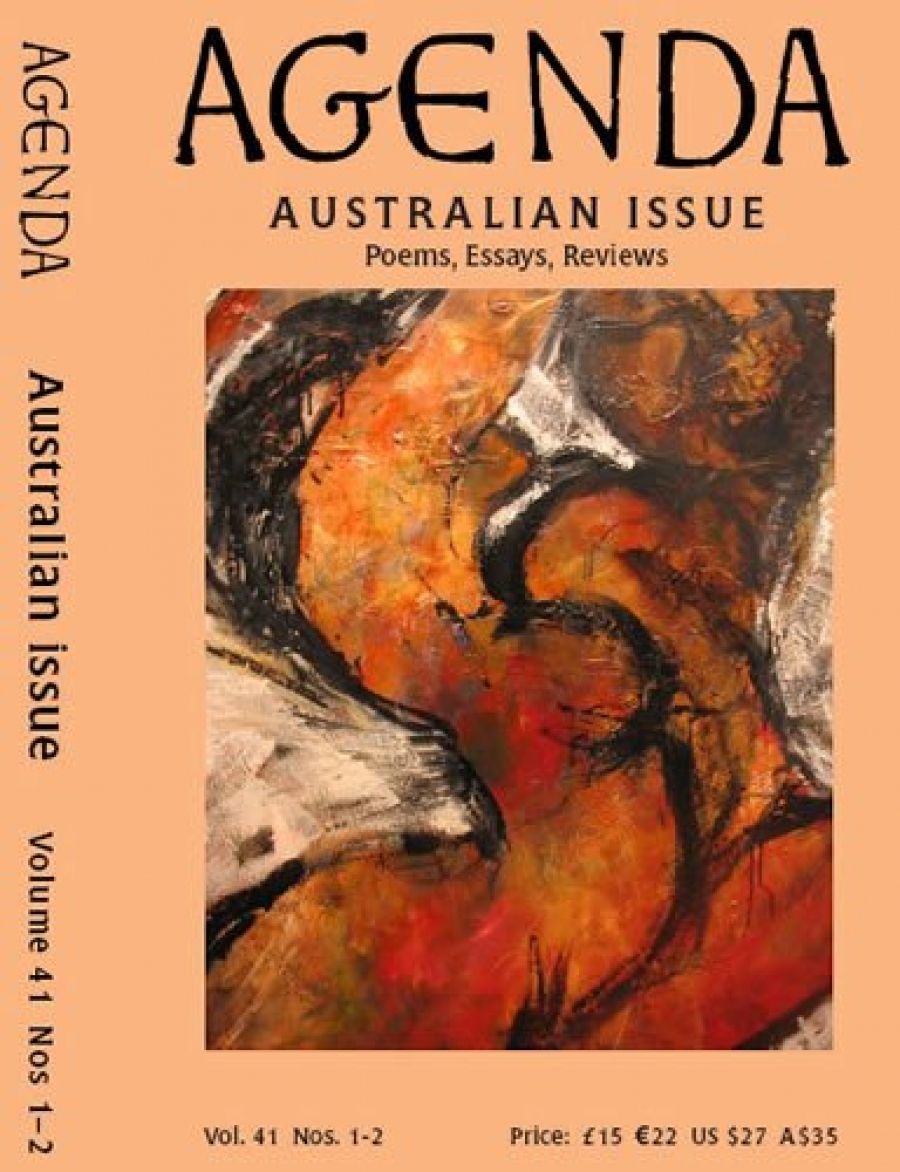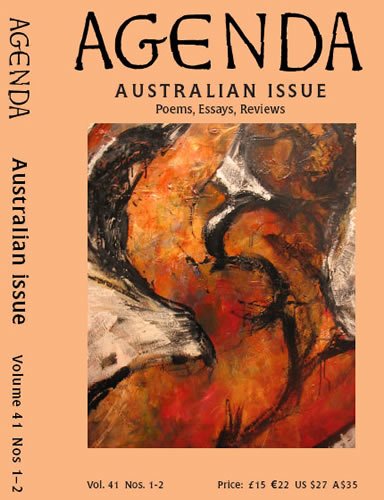
- Free Article: No
- Contents Category: Literary Studies
- Review Article: Yes
- Article Title: Retrospectives
- Online Only: No
- Custom Highlight Text:
William Cookson was eighteen. He had been writing to Ezra Pound for three years. At last he spent a week in Italy with the great man. ‘Does he ever speak?’ Pound asked his mother. Nonetheless, or as a consequence, Pound encouraged Cookson to start a literary magazine. Cookson founded Agenda in 1959 and edited it until his death in 2003.
- Book 1 Title: Agenda
- Book 1 Subtitle: Australian Issue
- Book 1 Biblio: Agenda, Volume 41, Nos 1–2, Spring/Summer 2005, $35 pb, 222 pp
- Book 1 Cover Small (400 x 600):

- Book 1 Cover (800 x 1200):

- Book 2 Title: Jacket 28, October 2005
- Book 2 Biblio: http://jacketmagazine.com/28/
The long poems are highlights of this issue. Take Hart’s ‘Dark Retreat’, compressed in style and baroque in spirit, like Richard Crashaw in the suburbs: ‘I went there yesterday / When someone left / A clock ajar: / There was no dust, / Only the faintest smell / Of half-drunk milk; // And you were there, / Dark One ...’
So, in one sense, the editor, Patricia McCarthy, is right in her claim: this issue proves ‘Australia is a vital, unique and highly energetic poetic force’; though the issue as a whole seems uncertain about what, if anything, Australia means to Australian poets. Probably this is how it ought to be; most Australian poets would disagree on the subject. Only this issue offers itself as an overview of the Australian scene, and thus sets itself up as more definitive.
According to its editorial policy, Agenda aims ‘to bring to English-speaking audiences poetry that they would not normally have access to’, and this issue seems designed for readers who know very little about Australia: there’s a map inside the back cover. It starts with three introductory essays and includes seven review essays on notable Australian writers. McCarthy suggests these essays ‘balance one another and give a perspective on Australian poetry in the past and now, elaborating on the literary scene in the Antipodes’.
Certainly, there are some fine essays here. Katherine Gallagher’s introductory essay describes the friendship between Oodgeroo Noonuccal and Judith Wright, and reflects on the difficulty and promise of reconciliation. Paul Kane remembers Philip Hodgins and marks out a place for humane values in his poetry. In a gently illuminating review essay, David McCooey pays tribute to Laurie Duggan; and, in an introductory essay, assesses the contemporary poetry scene, finding a ‘new lyricism’ that is lyricism plus worldliness and uncanny effects.
Still, it seems McCarthy claims too much when she suggests these fine essays ‘balance one another and give a perspective on Australian poetry in the past and now’. For instance, the review essays cover sixteen poets, only three of them female and those three grouped together in an essay from the editor on ‘women poets’. And the first essay reads as though no one told David Brooks it would be serving as an introduction to ‘Australian poetry in the past and now’ – for instance, Brooks mentions just three women: Judith Wright, Gig Ryan and Pam Brown. Instead, he enters the old bush versus city debate, claiming that ‘there is something retrospective, dated, about the concern for landscape in the first place’. This is, of course, thought-provoking; and Brooks acknowledges how few Australian poets fit either category (though Les Murray gets the usual, seemingly obligatory drubbing). Still, as an overview of ‘Australian poetry in the past and now’, his argument makes no place for poets you might well consider essential: Mary Gilmore, Dorothea MacKellar, Francis Webb, Gwen Harwood, Michael Dransfield, Robert Gray, David Malouf; and Brooks treats Bruce Chatwin’s Songlines (1987) as if it were a reliable guide to ‘the Dreamtime’. Like Brooks’s essay, this Agenda has many fine things in it; but it works more as a starting point than an overview.
The online poetry magazine Jacket, on the other hand, covers a remarkable range of poets in remarkable detail. A choose-your-own-adventure hyper-space encyclopedia, it features notable poets and ringleaders: their friendships, factions, letters, essays and reviews, as well as their poems. This issue covers critic and essayist Kenneth Cox, the Black Mountain poet Robert Duncan, and George Bowering, Canada’s first poet laureate.
In addition, it has perhaps a hundred poems, most notably Annie Finch’s ‘Feeding the Emperor’s Pussycat’, Peter Robinson’s suite of prose poems from Other Trespasses and David Lehman’s ‘To You’, which contains the best definition of a prose poem you’re likely to find: ‘As twenty measures of gin to one measure of dry vermouth make an acceptable Martini, so one unit of poetry converts twenty of prose into a prose poem.’ It also has interviews and more than thirty reviews, notably Larry Sawyer’s review of John Ashbery’s and Joe Brainard’s The Vermont Notebook, Ben Lerner’s review of W.S. Merwin’s Migration: New and Selected Poems, and Liz Parson’s review of Australian poet Michael Farrell’s ode ode.
The feature on Robert Duncan includes excerpts from letters that Duncan wrote to the Australian poet Chris Edwards (whose poems appear in Jacket 15) and letters to his one-time close friend, poet Denise Levertov. The letters to Levertov mark out Duncan’s commitment to poetry as an art outside politics: he vehemently opposes Levertov’s activism; her writing against the Vietnam war. His letters to Edwards also mark out his idea of poetry: ‘The close with its full rimes and its metaphorical current is, as I still feel it, dangerously poetic. Yet, the more so, I know it to be necessary ...’
With its vast place in hyperspace and endlessly ramifying links, Jacket can trace poets’ networks and interconnections across countries and generations. For instance, this issue shows how Robert Duncan’s writing influenced George Bowering. Bowering led a poetry revolution in Canada, similar to the one that Robert Adamson led here when the ‘Generation of ’68’ wrested control of Poetry Magazine:
Preferring an American postmodern poetic ... they initially dismissed the Canadian modernism ... that had been created from more British models, opting instead for heroes closer to their interest, such as Jack Spicer, Denise Levertov, Robert Creeley, Robert Olsen, Robin Blaser and Robert Duncan.
With this connection in mind, it is interesting to note Bowering’s early struggles against a national idea of poetry: ‘that the poetry is there to awaken you to how Canadians feel and so forth, rather than to tell you what the muses are telling the poets.’
Yet perhaps this issue’s most involving feature describes the life and work of a brilliant critic, Kenneth Cox. Born in London in 1919, his father a grocery manager, his mother part-gypsy, he taught himself French by reading labels on French products in his father’s store. During the war, he worked as a cryptographer in Cairo and Palestine, receiving an MBE for his work. After the war, he returned to London and stayed there for the rest of his life. In his fifties, he began publishing essays on literature in Agenda. According to August Kleinzahler, these are: ‘Models of clarity, concision and insight, they make a mockery of almost all contemporaneous academic criticism, which by comparison will strike the reader as fuzzy, ham-fisted, self-aggrandizing, tendentious and dim.’
Still, Cox struggled to find a publisher for his selected essays. Finally Agenda’s offshoot, Agenda Editions, published them, though Cox paid. It seems he considered his greatest achievement the promotion of little-known poet Lorine Niedecker, of whom he wrote:
The prevailing mood of the poems is alert calm. It conveys pathos, asperity or affectionate irony, rather as if one were in the presence of a relative from whom little is hid and to whom little needs to be explained. The poems acknowledge semi-articulate intimacies, their interrupted cadence, a shrewd tenderness, a tang.


Comments powered by CComment